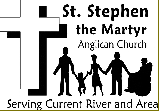Introduction to the Bible
The name Bible is taken from the place where papyrus is grown, Byblos, in Syria on the coast of the Mediterranean Sea.
The Bible is a library of books. Each book is divided into chapters, and each chapter into verses. To find a book, look in the table of contents.
The Old Testament is the Hebrew Bible. The Old and New Testaments combined is the Christian Bible.
The Apocrypha has semi-canonical status. It contains books written in the inter-testament period. The Anglican position on the Apocrypha is it is useful for the example of life and the instruction of manners, but not the proving of doctrine.
Writing of the Hebrew Bible
Oral traditions and official histories were written down. Just before the exile these sources were compiled into the Torah or Pentateuch (Genesis, Exodus, Leviticus, Numbers and Deuteronomy), and the Deuteronmic History (Joshua, Judges, 1 & 2 Samuel, 1 & 2 Kings).
The prophets and most the other writings were compiled during the exile.
Several books are post-exile: 1 & 2 Chronicles, Ezra, Nehemiah, Malachi, Job, Ecclesiastes, and Daniel.
Canonization of the Hebrew Bible
Canonization is the process of faith communities using books, and adopting those books that reflected the tradition of faith.
In the first century BCE, the Torah, Prophets and Psalms had agreement as scripture. The Writings were not agreed to until much later. The Septuagint was a Greek translation of the Hebrew scriptures c. 200 BCE. Those books that were in the Septuagint but not the Hebrew Canon, make up the Apocrypha.
Writing and Canonization of the New Testament
The Gospel of Mark is the earliest book, written about 70 CE. Luke and Matthew were the next Gospels written about 80 and 90 CE respectively. The Gospel of John was written last, about 95 CE.
Mark, Luke and Matthew are called the Synoptic Gospels. Luke and Matthew used Mark as a source, and they also have another common source called Q, which consists of sayings of Jesus (ex. Sermon on the plain or the mount). They each have an unique source (ex birth stories).
The letters of Paul were written next, 1 Thessalonians being the first. A number of letters were written in Paul’s name by another author ex. Ephesians, 1 Timothy.
2 Peter and Revelation of John were the last to be written, early in the 2nd century.
The Canon of the New Testament was basically agreed to in the mid 2nd century, but not formally closed until the 4th century.
Textual Criticism
The scriptures were copied by hand. Although much care was taken, errors entered in. Common errors are:
- Words or phrases dropped off,
- Words or phrases added, or
- Words changed.
One of the tasks of textual criticism is an attempt to create a critical text, which is as close as possible to the original text.
For the New Testament, the current critical text is good to the mid 2nd century or 30 to 70 years of the original document. The King James translation used originals good to the 10th century.
Translation
The Old Testament was written mainly in Hebrew, with a few books in Aramaic, and the New Testament in Greek.
Translation is the process whereby a literary work in one language is written in another language. The Bible is translated into in the language of the people. New translations of the Bible are needed as the language of the people changes, which is about every generation. The Anglican Church of Canada commonly uses the New Revised Standard Version (NRSV) in worship and for study, and it is written about a grade 11 reading level. The Good News Bible, written for people with English as a second language is written about a grade 6 reading level, is recommended for children.


